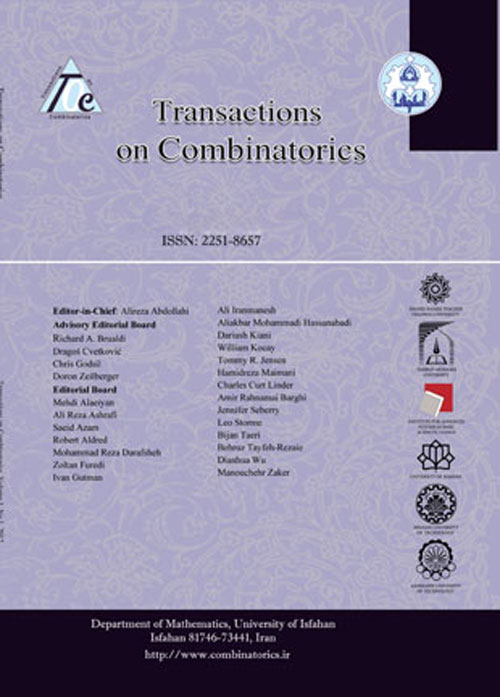فهرست مطالب

Transactions on Combinatorics
Volume:7 Issue: 2, Jun 2018
- تاریخ انتشار: 1396/11/16
- تعداد عناوین: 5
-
-
Pages 1-16In this paperý, ýwe consider statistics on permutations of length n represented geometrically as bargraphs having the same number of horizontal stepsý. ýMore preciselyý, ýwe find the joint distribution of the descent and up step statistics on the bargraph representationsý, ýthereby obtaining a new refined count of permutations of a given lengthý. ýTo do soý, ýwe consider the distribution of the parameters on permutations of a more general multiset of which Sn is a subsetý. ýIn addition to finding an explicit formula for the joint distribution on this multisetý, ýwe provide counts for the total number of descents and up steps of all its membersý, ýsupplying both algebraic and combinatorial proofsý. ýFinallyý, ýwe derive explicit expressions for the sign balance of these statisticsý, ýfrom which the comparable results on permutations follow as special casesý.Keywords: ?combinatorial statistic?, ?q-generalization?, ?bargraph?, ?permutations
-
Pages 17-23Let fn denotes the nth Fubini number. In this paper, first we give upper and lower bounds for the Fubini numbers fn. Then the log-convexity of the Fubini numbers has been obtained. Furthermore we also give the monotonicity of the sequence {fn−−√n}n≥1 by using the aforementioned bounds.Keywords: Fubini number, log-convexity, monotonicity
-
Pages 25-33The harmonic index of a graph G is defined as H(G)=∑uv∈E(G)2d(u)(v)ý, ýwhere d(u) denotes the degree of a vertex u in Gý. ýLet G(n,k) be the set of simple n-vertex graphs with minimum degree at least ký. ýIn this work we consider the problem of determining the minimum value of theý ýharmonic index and the corresponding extremal graphs among G(n,k)ý. ýWe solve the problem for each integer k(1≤k≤n/2) and show the corresponding extremal graph is the complete split graph K∗k,n−ký. ýThis result together with our previous result which solve the problem for each integer k(n/2≤k≤n−1) give a complete solution of the problemý.Keywords: ?harmonic index?, ?minimum degree?, ?extremal graphs
-
Pages 35-46Let G be a simpleý, ýoriented connected graph with n vertices and m edgesý. ýLet I(B) be the binomial ideal associated to the incidence matrix \textbf{B} of the graph Gý. ýAssume that IL is the lattice ideal associated to the rows of the matrix Bý. ýAlso let Bi be a submatrix of B after removing the i-th rowý. ýWe introduce a graph theoretical criterion for G which is a sufficient and necessary condition for I(B)=I(Bi) and I(Bi)=ILý. ýAfter that we introduce another graph theoretical criterion for G which is a sufficient and necessary condition for I(B)=ILý. ýIt is shown that the heights of I(B) and I(Bi) are equal to n−1 and the dimensions of I(B) and I(Bi) are equal to m−n; then I(Bi) is a complete intersection idealý.Keywords: Directed graph, Binomial ideal, Matrix ideals
-
Pages 47-54This paper investigates properties of the reduced zero-divisor graph of a poset. We show that a vertex is an annihilator prime ideal if and only if it is adjacent to all other annihilator prime ideals and there are always two annihilator prime ideals which are not adjacent to a non-annihilator prime ideal. We also classify all posets whose reduced zero-divisor graph is planar or toroidal and the number of distinct annihilator prime ideals is four or seven.Keywords: poset, reduced zero-divisor graph, annihilator prime ideal

